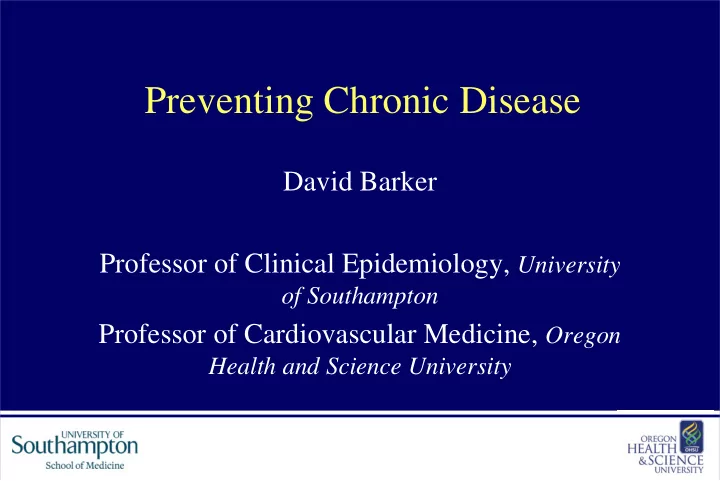

Preventing Chronic Disease David Barker Professor of Clinical Epidemiology, University of Southampton Professor of Cardiovascular Medicine, Oregon Health and Science University
The fetal origins of chronic disease • Coronary heart disease, Type 2 diabetes, hypertension, osteoporosis and asthma originate in developmental plasticity, in response to malnutrition during fetal life and infancy • Certain cancers also originate in this way
Mortality from coronary heart disease in 15726 men and women in Hertfordshire 120 Men 120 Women Standardised Mortality Ratio 100 100 80 80 60 60 40 40 20 20 ≤ 5.5 -6.5 -7.5 -8.5 -9.5 ≤ 5.5 -6.5 -7.5 -8.5 -9.5 >9.5 >9.5 Birthweight (pounds) Birthweight (pounds)
Hazard ratios for coronary heart disease in men 3 2.5 2 Hazard ratio 1.5 1 0.5 0 ≤ 16 17 18 19 20 21 22 23 24 25 26 27 >27 Weight at one year (pounds)
Programming Malnutrition and other adverse environmental exposures during development alter gene expression and programme the body’s structures and functions for life. Adverse exposures also result in slow growth and small body size.
Critical periods • Much of human development is completed during the first 1000 days after conception. • Each system and organ has a critical, often brief, period during which it has to develop. • Most critical periods occur in utero
During normal human growth the development of low priority organs, such as the lungs and kidneys, is traded-off to protect high priority organs, importantly the brain. Trade offs
Small body size at birth People who were small at birth are biologically different: • Reduced functional capacity e.g. fewer nephrons, less muscle • Altered metabolic settings e.g. insulin resistance • Altered hormonal production e.g. stress responses, sex hormones
Associations between early growth and later disease extend across the range of fetal and infant growth. This implies that what are regarded as normal variations in the supply of nutrients to the baby have important long–term effects.
Fetal nutrition Size at birth is the product of the fetus’s trajectory of growth, which is set soon after conception, and the materno-placental capacity to supply sufficient nutrients to maintain this trajectory.
Fetal Nutrition The fetus is nourished by • the mother’s diet • the nutrients stored in her body • her metabolism • the placenta’s ability to transport nutrients from mother to baby
Pelvic diameters
Hazard ratios for ovarian cancer according to mothers’ interspinous diameter and age at menarche Menarche at age 10 14 years or less p for trend 0.002 8 o i t a 6 r d r a 4 z a H Menarche at age 2 15 years or more p for trend 0.63 0 ≤ 25 25.1-26.0 26.1-27.0 >27.0 Interspinous diameter (cm)
Lung cancer according to head circumference at birth 1.5 p for trend=0.001 Hazard ratio 1 0.5 0 -33 -34 -35 -36 >36 Head circumference (cm)
Lung cancer according to placental area 3.5 p for trend=0.004 3 2.5 Hazard ratio 2 East 1.5 1 0.5 0 -200 -240 -280 -320 >320 Placental area (cm 2 )
Chronic disease The causes of chronic disease are linked to variations in the normal processes of development that programme a few key systems - the immune system, anti-oxidant defences, inflammatory responses and the number and quality of stem cells.
Recommend
More recommend